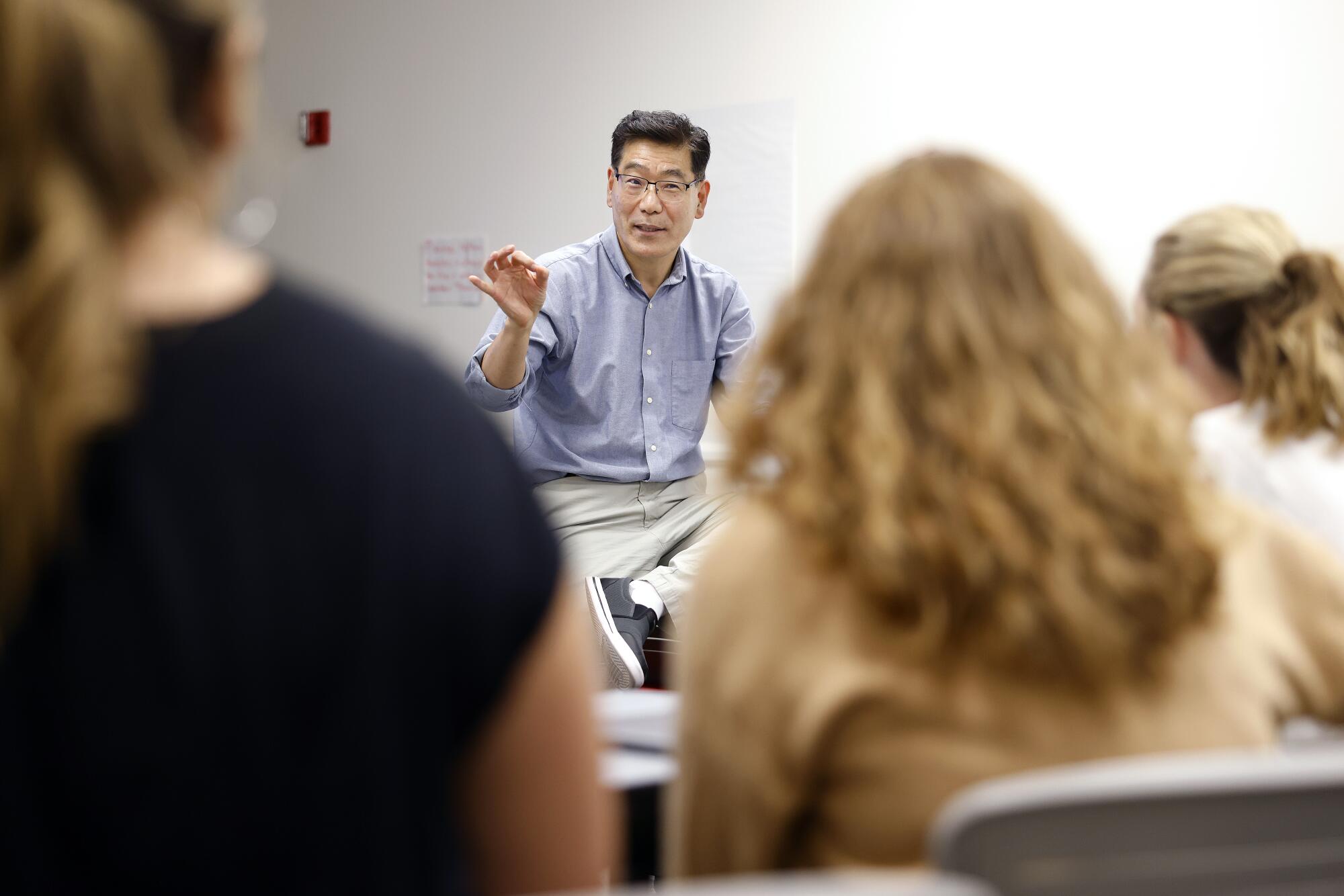Business
‘You just take it and take it.’ Immigrant workers describe discrimination they face on the job

A few days after arriving in Los Angeles, Joaquin Hurtado walked into a cafe in Studio City, asked for a manager, then recited one of the few phrases he’d memorized in English: “I’m looking for a job.”
If he would work for $2.60 an hour — then 30 cents below the minimum wage — the manager said, they could use a busboy.
That was 1979, and the then-17-year-old, who grew up on a ranch in central Mexico, had landed his first job in the U.S. It was followed, in years to come, by stints at other restaurants, a supermarket and a fiberglass factory, and as a day laborer.
Often working alongside other immigrants, Hurtado quickly noticed a through-line: It wasn’t uncommon, he said, for bosses to yell at them, short them on pay, schedule them for undesirable shifts or stiff them on raises.
“You just take it and take it,” Hurtado said. “It’s the way it is. They know they can do what they want.”
Hurtado’s employment situation improved drastically after President Reagan’s 1986 amnesty granted him legal status in the country and thus a pathway to a stable, union career as a garbage truck driver for the last three decades.
But his early work experiences are emblematic of the scope and frequency of on-the-job discrimination that immigrants to the U.S. continue to face.
The widespread nature of employment discrimination was a key finding of an unprecedented, nationwide poll of more than 3,000 immigrants conducted earlier this year by The Times in partnership with KFF, the nonprofit formerly known as the Kaiser Family Foundation.
Of the working immigrants surveyed, nearly half — 47% — reported being paid less than U.S.-born workers to do the same job, not being paid for all their hours worked, being given fewer opportunities for promotions or raises, getting worse shifts or having less control over their hours, or being harassed or threatened in the workplace because they were immigrants.
Many said they had experienced multiple forms of discrimination. Among those whom the survey identified as likely to be undocumented — immigrants who reported that they were not citizens and did not have a valid green card or visa — two-thirds reported workplace mistreatment. So did 55% of those who said they didn’t speak English well, according to the poll, which surveyed immigrants with a wide range of careers and statuses under U.S. law.
“There’s a lot of racism,” said an immigrant in Texas who has worked in produce warehouses and who participated in one of several focus groups done alongside the survey. “Because we were undocumented, we worked more and earned less.”

Joaquin Hurtado at home with daughter Monica Espinoza Pasillas. When he began working in the U.S., he quickly noticed that bosses tended to short him and other immigrants on pay, schedule them for undesirable shifts or stiff them on raises. “It’s the way it is.”
(Dania Maxwell / Los Angeles Times)
In interviews, several immigrants who participated in the poll, including Hurtado, described contentment with aspects of the lives they’d built, but also nostalgia and sometimes exhaustion. Others spoke of a sense of gratitude tempered by the feeling that, at least in the workplace, they often weren’t seen or rewarded for their full potential.
For several years, that’s how HeeKap Lee felt.
After emigrating from South Korea in his early 30s, he earned a doctorate in education at Indiana University Bloomington and eventually moved to rural Kentucky for an associate professorship at a small Christian university.

HeeKap Lee, a professor at Azusa Pacific University, emigrated from South Korea in his early 30s. During his time teaching in rural Kentucky, he says, “I always felt like an outsider.”
(Christina House / Los Angeles Times)
“I was the first nonwhite faculty since the school started,” Lee said, sighing as he recounted the way people stared at him on campus and around town. “I always felt like an outsider.”
He once found several dead birds tossed into his front yard; another time, Lee said, he walked outside to find his mailbox smashed. He tried to convince himself it was an accident, but, if so, wouldn’t someone have left a note?
He prayed, asking God to send him somewhere else, and eventually moved to a small university in Ohio. Although it was better, Lee said, he twice was passed over for a promotion from associate professor to full professor. He had plenty of research experience, he said, and remembers thinking it didn’t feel fair.
“I didn’t lack anything,” he said.
His situation improved drastically in 2009 when he moved to Southern California for a job at Azusa Pacific University, where he still works as a professor.
“In L.A.,” he said, “I’m part of all the diversity.”
Lee, 58, who co-authored a book titled “Multiculturalism,” said he feels proud of the work he’s doing now, knowing that, as an immigrant, his perspective helps shape his students who go on to become teachers themselves, working with students from all different cultures.

HeeKap Lee, now 58, co-authored a book titled “Multiculturalism” and says his perspective as an immigrant helps his students, some of whom go on to become teachers themselves.
(Christina House / Los Angeles Times)
“The power of this country,” he said, “is to embrace diversity as our driving force.”

Although Lee and Hurtado have spent decades in the U.S., a third immigrant, who participated in a focus group in L.A. as part of the Los Angeles Times/KFF research, arrived seven years ago, fleeing death threats in her native Honduras.
Now 20, Sharon, who requested her surname be withheld for privacy, grew up in a coffee-growing region on the western edge of the country. As a girl, she plucked mangoes from trees when food ran scarce, sliced them and sold them to students at her school.
When she was 13, her father received word that members of a rival gang planned to kill him but intended to target his daughters first to make him suffer. Almost immediately, Sharon and her younger sister, then 8, boarded a bus headed north.

Sharon, 20, emigrated at 13 from Honduras when her family received death threats. She is the mother of two young children.
(Dania Maxwell / Los Angeles Times)
They eventually arrived in Texas, she said, and spent several weeks in migrant detention facilities with other unaccompanied minors, receiving English lessons where the adults insisted on being addressed as “Teacher.”
The habit stuck and, once reunited with her mother in L.A., she forced herself to participate in her seventh-grade classes despite knowing very little English. While other students addressed teachers as either “Mr.” or “Miss,” she started her questions the way she had learned in Texas.
Other students taunted her, nicknaming her “Teacher Girl.” Already discouraged, she soon got a call saying her father was missing, and then a text from a relative in Honduras with a picture of a lifeless body in a red sack tossed in a dry creek bed. Only his legs were showing, but Sharon immediately recognized his jeans.
She screamed so much that she fainted and, for months felt despondent, skipping school to sleep or wander the city. Deeply apathetic, she began pulling out of her blinding depression only after learning that she was pregnant.
“My daughter saved me,” she said. “She became my motivation.”
Sharon began looking for work, but knew it would be hard without legal work documents or English skills. The owner of a 99 cents store where she sometimes shopped in South L.A. needed someone to run the cashier for 11-hour shifts Monday through Friday.
The pay was $400 a week.
That was far below minimum wage, Sharon knew, but it felt like her only option. The owner hadn’t asked for work documents and told her she could bring her baby with her during her shifts. She worked there for several months, but quit after the store was robbed at gunpoint while she was eight months pregnant with her second daughter.

Sharon, who asked that her last name not be used for privacy, saw her situation improve two years ago when she received paperwork allowing her to work legally in the U.S. But she still struggles as a young mother.
(Dania Maxwell / Los Angeles Times)
In the years since, she has pieced together work, packaging orders at a corner store, delivering for UberEats, disinfecting an office building during the pandemic and cleaning the drink-crusted floors of a nightclub near Koreatown.
She also worked Friday and Saturday nights cleaning the bar and serving drinks at the club, although she was limited to delivering beverages without alcohol since she wasn’t yet 21. Almost every shift, she said, a customer propositioned her.
“You’re an immigrant, right?” she recalled one man saying. “Don’t you want to make more money?”
“When you’re done here,” another man said, “I’ll give you $500 to meet me.”
“No, sorry,” she told them. “I don’t do that.”
She felt exhausted and guilty that, in her rare downtime, she had little energy to play with her daughters. At a temporary office cleaning gig, she had a backpack vacuum strapped to her small frame for eight hours, and it got so hot it often left a red mark on her back.
She was often given more work than she could finish during her allotted hours, she said, and although she stayed to finish she was never paid for the extra hours. When she explained the situation to a boss and mentioned she might contact a workers’ rights group, she stopped getting scheduled for shifts.
“They’ve never taken me seriously at my jobs,” she said. “They think I’m just a little doll. They don’t know what I’m capable of.”
Her situation improved somewhat in 2021, when she got paperwork allowing her to work legally in the U.S. But she still has two big hurdles. She needs something with enough flexibility that, if her daughters’ daycare calls, she can pick them up within an hour, and she needs to improve her English.

After inquiring about work at a McDonald’s in the Pico-Union neighborhood, she was told she needed to know a bit more English — a reality, she said, that makes her feel defeated, questioning if she could’ve tried harder to learn the language when she arrived.
“Maybe it’s my own fault?” she says, pausing before growing more definitive. “It is my fault.”
Then she pauses again, reflecting on how young and deeply depressed she was at the time, and her voice cracks.
“But I was just a girl.”

Growing up in the Mexican state of Zacatecas, Hurtado lived miles from the nearest secondary school.
There was no bus and it was too far to walk, so as a teenager, he moved to his grandfather’s ranch and spent his days helping him herd cattle and gather firewood. At 17, he did what many teenagers in his family and town had done: He headed to the U.S.
After arriving in Los Angeles on July 4, 1979, he quickly landed the busboy job in Studio City, but it lasted only a week. When a customer asked for a glass of water in English, he didn’t understand and, making a guess and hoping for the best, took them a cup of coffee. The manager told him he could come back if he learned more English.
Next came a dishwashing gig at a spot called Pizzeria Numero 1, where he worked his way up to food prep and then chef. By the early 1980s, not long after getting married and learning his wife was pregnant, he had a job waxing the floors at a Hughes supermarket in the San Fernando Valley.
During one of his shifts, he asked a co-worker to cover for him while he took his lunch break, Hurtado recalled, and during that time a customer shattered a jar of mayonnaise on the floor and someone slipped on it. The person made a complaint, Hurtado said, and his boss insisted that, since it had happened during his shift, it was his fault and that he was being fired.
He explained to his boss that he’d asked for coverage, Hurtado said, but he could tell his boss had made up his mind. It was an injustice, Hurtado said, but one he couldn’t dwell on long because he needed to focus on finding a job before his baby was born. He eventually found work at a fiberglass factory in Sylmar, earning around $3 an hour.
“I can’t live like this,” he recalled thinking. “I need a higher salary.”
He started taking English classes at night and, after the 1986 amnesty, became one of the roughly 3 million undocumented immigrants, many in California, granted legal status. He finally had some bargaining power.
“How much will you pay me?” he’d ask potential employers. “That’s not enough, I’m not interested.”

Joaquin Hurtado lives with his family in a rented two-bedroom home in North Hills and hopes to retire in a few years.
(Dania Maxwell / Los Angeles Times)
Around that time, a friend who worked as a garbage truck driver offered to help train him for the same role. After six months of studying, he got his license and found a job making $16 an hour. For years, he hadn’t saved much of anything and now, in a single year, he amassed $38,000, enough for a down payment on a four-bedroom home in Sylmar.
“A beautiful house,” he said proudly. “My own house.”
A devotee to the world of Mexican rodeo known as charrería, Hurtado, who said nothing melts away his stress like riding a horse in the open air, soon saved enough to buy a sprawling property in Acton, as well as a horse and trailer.
Eventually, he separated from his wife, and she kept the home in Sylmar. For a while, he lived with his elderly parents in their mobile home nearby and went on to marry Yadira Pasillas Alamillo, an elementary school teacher he knew from back in Zacatecas.
Earlier this summer, she and her two youngest daughters, Monica Espinoza Pasillas, 12, and Deicy Espinoza Pasillas, 18, who Hurtado considers his own, left Mexico and moved in with him in a 2-bedroom home he’s renting in North Hills.
The family planted pink flowers and a small olive tree outside, and inside Hurtado’s wife has tacked up blue post-its to remind her and the girls of the English words and pronunciations — “wall (gual),” one reads. Monica recently enrolled in seventh grade, and Deicy and their mother are taking an immersive English course three hours a day, five days a week.
On a recent afternoon, all three lounged on the couch, updating each other on what they’d learned recently.
Deicy, who hopes to become a plastic surgeon, said that, with the help of a TikTok video, she could finally hear the difference between “tree” and “three.”

Deicy Espinoza Pasillas, 18, assists her mother, Yadira Pasillas Alamillo, with English homework. Deicy hopes to become a plastic surgeon.
(Dania Maxwell / Los Angeles Times)
Her mother, who plans to return to teaching or pursue a nursing degree once she’s learned more English, said she’d learned the phrase “the big cheese,” which frustratingly, she noted, didn’t translate to anything related to cheese but rather to el pez gordo (the fat fish).
Monica, who teared up as she spoke about her friends back in Mexico, said that some students from her new school from Guatemala and Colombia had helped her when she couldn’t understand their teacher.
Her mother wrapped her in a tight hug and Hurtado handed her a blue handkerchief, saying he knew that feeling of nostalgia, but was proud of her for the progress she’d made in just a few weeks.
“You’re getting into a rhythm,” he told her. And it was something he was eager to do himself.
Off work to recover from a shoulder surgery in August, the 61-year-old now fills his days with physical therapy appointments and twice-a-day, at-home mobility exercises.

Joaquin Hurtado does his physical therapy following shoulder surgery in August. He says he still enjoys his job driving a garbage truck, especially the interactions with customers.
(Dania Maxwell / Los Angeles Times)
Hurtado, who now makes $32 an hour and hopes to retire in about three years, said he still enjoys his shifts at the wheel of his truck, especially the interactions with customers. When he’s working, he wakes around 4 a.m., picks up his truck and then a treat from a corner store — a juice or ice cream — and traces a route that often winds through Alhambra, Pasadena and La Cañada Flintridge.
“I like what I’m doing,” he said. “I love my job.”

Business
How Poshmark Is Trying to Make Resale Work Again

Lauren Eager got into thrifting in high school. It was a way to find cheap, interesting clothes while not contributing to the wastefulness of fast fashion.
In 2015, in her first year of college, she downloaded the app for Poshmark, a kind of Instagram-meets-eBay resale platform. Soon, she was selling as well as buying clothes.
This was the golden age of online reselling. In addition to Poshmark, companies like ThredUp and Depop had sprung up, giving a second life to old clothes. In 2016, Facebook debuted Marketplace. Even Goodwill got into the action, starting a snazzy website.
The platforms tapped into two consumer trends: buying stuff online and the never-gets-old delight of snagging a gently used item for a fraction of the original cost. During the Covid-19 pandemic, as people cleaned out their closets, enthusiasm for reselling intensified. It was so strong that Poshmark decided to go public. On the day of its initial public offering in January 2021, the company’s market value peaked at $7.4 billion, roughly the same as PVH’s, the company that owns Calvin Klein and Tommy Hilfiger, at the time.
Then, the business of old clothes started to fray.
Using the Poshmark app, Ms. Eager and others said, started to feel like trying to find something in a messy closet. The app was cluttered with features that did not work or that she did not use, and it felt “spammy,” she said, sending too many push notifications.
Many platforms found selling used items hard to scale. Now, online resellers are trying to recalibrate. Last year, ThredUp decided to exit Europe and focus on selling in the United States. Trove, a company that helps brands like Canada Goose and Steve Madden resell their goods, purchased a competitor, Recurate. The RealReal, a luxury consignor, appointed a new chief executive as the company tried to improve profitability.
Poshmark is undergoing perhaps the biggest reinvention. In 2023, Naver, South Korea’s biggest search engine as well as an online marketplace, bought the company in a deal valued at $1.6 billion, less than half its IPO price.
Something of a mash-up of Google and Amazon, Naver is betting it can rebuild Poshmark, which has 130 million active users, with the same technology that made Naver dominant in its own country.
It may also help breathe new life into the resale market. Analysts think the resale fashion market still has room to grow in the United States, with revenue expected to increase 26 percent to $36.3 billion by 2028, according to the retail consultancy firm Coresight Research.
New legislation in California could help. The law, passed last year, requires brands and retailers that operate in the state and generate at least $1 million to set up a “producer responsibility organization” to collect and then reuse, repair or recycle its products. Resale platforms like ThredUp and Poshmark could be in a position to help brands carry out that mandate.
At the moment, though, Naver’s focus for Poshmark is more basic: Make it a better place to sell and shop. The company has the “operating know-how” to do that, said Philip Lee, a founder of the media outlet The Pickool, which covers both South Korean and U.S. tech companies.
“They’re trying to renovate Poshmark and then expand the market share,” he said.
A Marriage of Search and Commerce
Poshmark, which is based in Redwood City, Calif., was founded in 2011 by Manish Chandra, an entrepreneur and former tech executive, and three others. In trying to expand, Poshmark faced a problem common to resellers: Capturing the excitement of the secondhand-shopping treasure hunt while not frustrating buyers with an endless scroll. The company knew it needed better search, as well as interactive elements that gave people more reasons to come beyond paying $19 for a J. Crew sweater.
For its part, Naver was looking for ways to push beyond South Korea, where its commerce and search businesses were already mature. The growing online resale market in the United States presented an opportunity, and also gave the company access to the largest consumer market in the world.
“Commerce is a big growth engine for us,” Namsun Kim, Naver’s chief financial officer, said. And the peer-to-peer sector, where users sell to one another, was still in its infancy, with room to expand. But, Mr. Kim added, “it’s a more challenging segment, and that’s why it’s harder for a lot of the larger players to enter.”
There are two common business models for resale: peer-to-peer and consignment. With consignment, a platform collects and redistributes physical goods. Poshmark uses the peer-to-peer model, which relies on scores of people — many of them novices — haggling over prices and then mailing items to one another. This decentralization can be a headache for brands, which like to maintain a certain level of control of their products. And platforms like Poshmark must make buyers comfortable with trusting the sellers on their site.
Before the Naver purchase, it was difficult to push through needed technological changes, said Vanessa Wong, the vice president of product at Poshmark.
“I would always talk to my engineers and ask, ‘What if we do this or do that?’ They’re like, ‘That’s hard. The effort’s really high,’” Ms. Wong said.
Naver’s purchase offered both the investment and the expertise to pull off the changes. Founded in 1999, the company is everywhere in South Korea.
“We are not just a simple search technology or A.I. service,” said Soo-yeon Choi, the chief executive of Naver, whose headquarters are near Seoul. The company, she said, “alleviates the frustrations of people, which is what is needed to help growth.”
Search built Naver “into the massive power that they are in Korea,” said Mr. Chandra, who stayed on as chief executive after Naver’s purchase. It was the top priority when the company bought Poshmark.
Several new elements for users and sellers have been introduced. With a tool called Posh Lens, users can take a photo of an item and, using Naver’s machine-learning technology, the site populates listings that are the same or similar to the shoe or tank top that they’re searching for. A paid ad feature for sellers called “Promoted Closet,” pushes listings higher on customer feeds.
Poshmark also introduced live shows, some of which are themed, to draw in the TikTok generation and increase engagement. One party auctioned off clothing previously worn by South Korean celebrities, a connection that was made with the help of Naver.
Still, the resale market is going through growing pains and has not quite found its footing since the height of the pandemic. It’s not clear whether the changes taking place at Poshmark will be enough. In May, Mr. Kim, Naver’s finance chief, said in an earnings call that Poshmark’s profitability was improving, but by November, the company was cautioning that growth had slowed because of weakness in the peer-to-peer resale market in North America.
Missteps and Reinvention
The company has already done some backpedaling on unpopular decisions.
In October, Poshmark introduced a new fee structure, which increased costs for buyers. Sellers, fearing that higher costs would make consumers bolt, revolted. Within weeks, the company scrapped the new fee structure.
And there are still user headaches: tags and keywords that help users find what they’re looking for can be miscategorized. Sellers sometimes tag their products incorrectly to get more eyeballs on their less popular products. (Hard-to-offload Amazon leggings, for example, may be listed as Free People apparel.)
The company is beta testing changes with its frequent sellers — people like Alex Mahl, who sells thousands of dollars in apparel on the site each year. And within dedicated Facebook groups related to Poshmark, there’s a lot of chatter about the changes that sellers and buyers would still like to see.
“The only way for it to do well is there’s going to be constant changes,” Ms. Mahl said about the tweaks on Poshmark. “If you were just on an app that never changed — one, it would be boring, and two, the opportunity to just do better wouldn’t be there.”
One recent morning, Ms. Eager, the seller who joined Poshmark back in college, was pleasantly surprised to find that the app had some new features she actually liked. She snapped a photo of her Aerie gray tank top with Posh Lens. Within seconds, the app populated listings of similar products. It was so much better than conjuring up the adjectives needed to describe it.
“Love it,” Ms. Eager exclaimed.
Business
When receipts of home renovations are lost, is the tax break gone too?

Dear Liz: I have sold my family home recently after almost 50 years. I had done lots of improvements throughout those years. Due to a fire 15 years ago, all the documentation for these improvements has been destroyed. How do I document the improvements for the capital gains tax calculation?
Answer: As you probably know, you can exclude $250,000 of capital gains from the sale of a principal residence as long as you own and live in the home at least two of the previous five years. The exclusion is $500,000 for a couple.
Once upon a time, that meant few homeowners had to worry about capital gains taxes on the sale of their home. But the exclusion amounts haven’t changed since they were created in 1997, even as home values have soared. Qualifying home improvements can be used to increase your tax basis in the home and thus decrease your tax bill, but the IRS probably will demand proof of those changes should you be audited.
You could ask any contractors you used who are still in business if they will provide written verification of the work they performed, suggests Mark Luscombe, principal analyst for Wolters Kluwer Tax & Accounting. You also could check your home’s history with your property tax assessor to see if its assessment was adjusted to reflect any of the improvements.
At a minimum, prepare a list from memory of the improvements you made, including the year and the approximate cost. If you don’t have pictures of the house reflecting the changes, perhaps friends and relatives might. This won’t be the best evidence, Luscombe concedes, but it might get the IRS to accept at least some increase in your tax basis.
If you’re a widow or widower, there’s another tax break you should know about. At least part of your home would have gotten a step-up in tax basis if you were married and your co-owner spouse died. In most states, the half owned by the deceased spouse would get a new tax basis reflecting the home’s current market value. In community property states such as California, both halves of the house get this step-up. A tax pro can provide more details.
Other homeowners should take note of the importance of keeping good digital records. While documents may not be lost in a fire, they may be misplaced, accidentally discarded or (in the case of receipts) so faded they’re illegible. To make sure documents are available when you need them, consider scanning or taking photographs of your records and keeping multiple copies, such as one set in your computer and another in a secure cloud account.
When an employee is misclassified as contractor
Dear Liz: A parent recently wrote to you about a son who was being paid as a contractor. I know someone else who got a job that did not “take out taxes from his paycheck.” Such workers believe they are pocketing more money, but unfortunately, too many do not know about the nature of withholding. They only learn if they choose to file for their expected refund, but instead discover an exorbitant tax liability that a paycheck-to-paycheck worker cannot pay.
The sad fact is that many of these employers improperly classify their workers, who are truly employees, as independent contractors! And they do this to avoid paying their own portion of Social Security and unemployment taxes and also workers compensation insurance.
If workers believe that they have been misclassified (the IRS website provides all criteria), they can file IRS Form SS-8 and Form 8919, which will allow them to pay only their allocated half of their Social Security taxes. Hopefully the IRS will then contact these employers to correct their wrong classifications. And finally, it should be a law that, when hired, all true independent contractors should be given a clear form (not fine print on their employment agreements) that informs them of their status and the need to make estimated tax payments.
Answer: A big factor in determining whether a worker is an employee or contractor is control. Who controls what the worker does and how the worker does the job? The more control that’s in the employer’s hands, the more likely the worker is an employee.
However, the IRS notes that there are no hard and fast rules and that “factors which are relevant in one situation may not be relevant in another.”
The form you mentioned, IRS Form SS-8, also can be filed by any employer unsure if a worker is properly classified.
Liz Weston, Certified Financial Planner®, is a personal finance columnist. Questions may be sent to her at 3940 Laurel Canyon, No. 238, Studio City, CA 91604, or by using the “Contact” form at asklizweston.com.
Business
Inside Elon Musk’s Plan for DOGE to Slash Government Costs

An unpaid group of billionaires, tech executives and some disciples of Peter Thiel, a powerful Republican donor, are preparing to take up unofficial positions in the U.S. government in the name of cost-cutting.
As President-elect Donald J. Trump’s so-called Department of Government Efficiency girds for battle against “wasteful” spending, it is preparing to dispatch individuals with ties to its co-leaders, Elon Musk and Vivek Ramaswamy, to agencies across the federal government.
After Inauguration Day, the group of Silicon Valley-inflected, wide-eyed recruits will be deployed to Washington’s alphabet soup of agencies. The goal is for most major agencies to eventually have two DOGE representatives as they seek to cut costs like Mr. Musk did at X, his social media platform.
This story is based on interviews with roughly a dozen people who have insight into DOGE’s operations. They spoke to The Times on the condition of anonymity because they were not authorized to speak publicly.
On the eve of Mr. Trump’s presidency, the structure of DOGE is still amorphous and closely held. People involved in the operation say that secrecy and avoiding leaks is paramount, and much of its communication is conducted on Signal, the encrypted messaging app.
Mr. Trump has said the effort would drive “drastic change,” and that the entity would provide outside advice on how to cut wasteful spending. DOGE itself will have no power to cut spending — that authority rests with Congress. Instead, it is expected to provide recommendations for programs and other areas to cut.
But parts of the operation are becoming clear: Many of the executives involved are expecting to do six-month voluntary stints inside the federal government before returning to their high-paying jobs. Mr. Musk has said they will not be paid — a nonstarter for some originally interested tech executives — and have been asked by him to work 80-hour weeks. Some, including possibly Mr. Musk, will be so-called special government employees, a specific category of temporary workers who can only work for the federal government for 130 days or less in a 365-day period.
The representatives will largely be stationed inside federal agencies. After some consideration by top officials, DOGE itself is now unlikely to incorporate as an organized outside entity or nonprofit. Instead, it is likely to exist as more of a brand for an interlinked group of aspirational leaders who are on joint group chats and share a loyalty to Mr. Musk or Mr. Ramaswamy.
“The cynics among us will say, ‘Oh, it’s naïve billionaires stepping into the fray.’ But the other side will say this is a service to the nation that we saw more typically around the founding of the nation,” said Trevor Traina, an entrepreneur who worked in the first Trump administration with associates who have considered joining DOGE.
“The friends I know have huge lives,” Mr. Traina said, “and they’re agreeing to work for free for six months, and leave their families and roll up their sleeves in an attempt to really turn things around. You can view it either way.”
DOGE leaders have told others that the minority of people not detailed to agencies would be housed within the Executive Office of the President at the U.S. Digital Service, which was created in 2014 by former President Barack Obama to “change our government’s approach to technology.”
DOGE is also expected to have an office in the Office of Management and Budget, and officials have also considered forming a think tank outside the government in the future.
Mr. Musk’s friends have been intimately involved in choosing people who are set to be deployed to various agencies. Those who have conducted interviews for DOGE include the Silicon Valley investors Marc Andreessen, Shaun Maguire, Baris Akis and others who have a personal connection to Mr. Musk. Some who have received the Thiel Fellowship, a prestigious grant funded by Mr. Thiel given to those who promise to skip or drop out of college to become entrepreneurs, are involved with programming and operations for DOGE. Brokering an introduction to Mr. Musk or Mr. Ramaswamy, or their inner circles, has been a key way for leaders to be picked for deployment.
That is how the co-founder of Loom, Vinay Hiremath, said he became involved in DOGE in a rare public statement from someone who worked with the entity. In a post this month on his personal blog, Mr. Hiremath described the work that DOGE employees have been doing before he decided against moving to Washington to join the entity.
“After 8 calls with people who all talked fast and sounded very smart, I was added to a number of Signal groups and immediately put to work,” he wrote. “The next 4 weeks of my life consisted of 100s of calls recruiting the smartest people I’ve ever talked to, working on various projects I’m definitely not able to talk about, and learning how completely dysfunctional the government was. It was a blast.”
These recruits are assigned to specific agencies where they are thought to have expertise. Some other DOGE enrollees have come to the attention of Mr. Musk and Mr. Ramaswamy through X. In recent weeks, DOGE’s account on X has posted requests to recruit a “very small number” of full-time salaried positions for engineers and back-office functions like human resources.
The DOGE team, including those paid engineers, is largely working out of a glass building in SpaceX’s downtown office located a few blocks from the White House. Some people close to Mr. Ramaswamy and Mr. Musk hope that these DOGE engineers can use artificial intelligence to find cost-cutting opportunities.
The broader effort is being run by two people with starkly different backgrounds: One is Brad Smith, a health care entrepreneur and former top health official in Mr. Trump’s first White House who is close with Jared Kushner, Mr. Trump’s son-in-law. Mr. Smith has effectively been running DOGE during the transition period, with a particular focus on recruiting, especially for the workers who will be embedded at the agencies.
Mr. Smith has been working closely with Steve Davis, a collaborator of Mr. Musk’s for two decades who is widely seen as working as Mr. Musk’s proxy on all things. Mr. Davis has joined Mr. Musk as he calls experts with questions about the federal budget, for instance.
Other people involved include Matt Luby, Mr. Ramaswamy’s chief of staff and childhood friend; Joanna Wischer, a Trump campaign official; and Rachel Riley, a McKinsey partner who works closely with Mr. Smith.
Mr. Musk’s personal counsel — Chris Gober — and Mr. Ramaswamy’s personal lawyer — Steve Roberts — have been exploring various legal issues regarding the structure of DOGE. James Burnham, a former Justice Department official, is also helping DOGE with legal matters. Bill McGinley, Mr. Trump’s initial pick for White House counsel who was instead named as legal counsel for DOGE, has played a more minimal role.
“DOGE will be a cornerstone of the new administration, helping President Trump deliver his vision of a new golden era,” said James Fishback, the founder of Azoria, an investment firm, and confidant of Mr. Ramaswamy who will be providing outside advice for DOGE.
Despite all this firepower, many budget experts have been deeply skeptical about the effort and its cost-cutting ambitions. Mr. Musk initially said the effort could result in “at least $2 trillion” in cuts from the $6.75 trillion federal budget. But budget experts say that goal would be difficult to achieve without slashing popular programs like Social Security and Medicare, which Mr. Trump has promised not to cut.
Both Mr. Musk and Mr. Ramaswamy have also recast what success might mean. Mr. Ramaswamy emphasized DOGE-led deregulation on X last month, saying that removing regulations could stimulate the economy and that “the success of DOGE can’t be measured through deficit reduction alone.”
And in an interview last week with Mark Penn, the chairman and chief executive of Stagwell, a marketing company, Mr. Musk downplayed the total potential savings.
“We’ll try for $2 trillion — I think that’s like the best-case outcome,” Mr. Musk said. “You kind of have to have some overage. I think if we try for two trillion, we’ve got a good shot at getting one.”
-

 Politics1 week ago
Politics1 week agoCarter's judicial picks reshaped the federal bench across the country
-

 Politics1 week ago
Politics1 week agoWho Are the Recipients of the Presidential Medal of Freedom?
-

 Health1 week ago
Health1 week agoOzempic ‘microdosing’ is the new weight-loss trend: Should you try it?
-

 World1 week ago
World1 week agoSouth Korea extends Boeing 737-800 inspections as Jeju Air wreckage lifted
-
/cdn.vox-cdn.com/uploads/chorus_asset/file/25822586/STK169_ZUCKERBERG_MAGA_STKS491_CVIRGINIA_A.jpg)
/cdn.vox-cdn.com/uploads/chorus_asset/file/25822586/STK169_ZUCKERBERG_MAGA_STKS491_CVIRGINIA_A.jpg) Technology4 days ago
Technology4 days agoMeta is highlighting a splintering global approach to online speech
-

 News1 week ago
News1 week agoSeeking to heal the country, Jimmy Carter pardoned men who evaded the Vietnam War draft
-

 News1 week ago
News1 week agoTrump Has Reeled in More Than $200 Million Since Election Day
-

 News1 week ago
News1 week agoThe U.S. Surgeon General wants cancer warnings on alcohol. Here's why




/cdn.vox-cdn.com/uploads/chorus_asset/file/25822588/STK169_ZUCKERBERG_MAGA_STKS491_CVIRGINIA_B.jpg)









